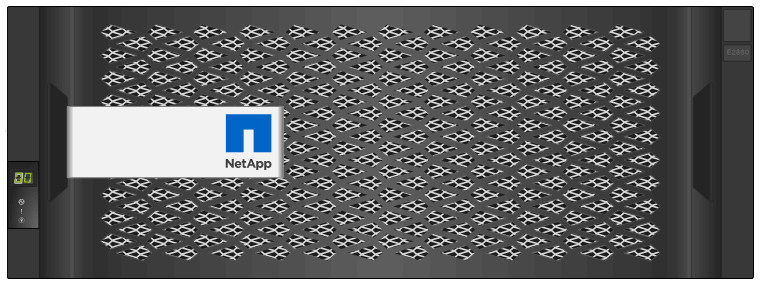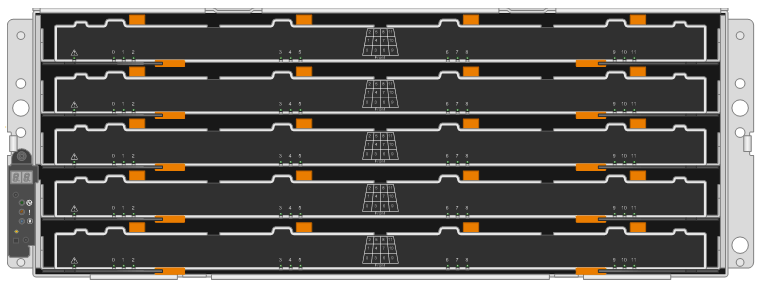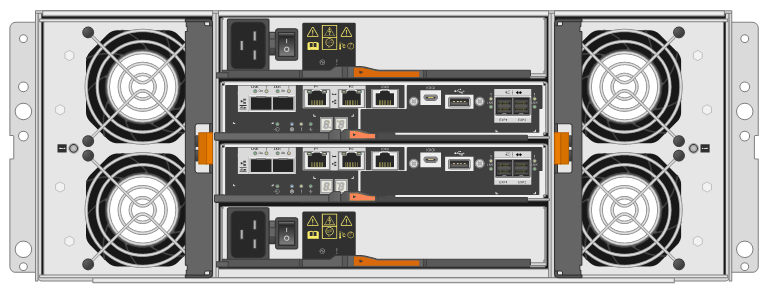Overview:
Your enterprise relies on core applications that are critical to business success. Getting value and insights quickly and reliably from a range of mixed workload environments can differentiate your organization from the competition and accelerate time to market. To compete today, you need data storage systems that can deliver exceptional application performance with nonstop data availability.
Your enterprise must have storage that can meet your performance and capacity demands without sacrificing simplicity and efficiency. That’s why the NetApp® E5700 system was designed with NetApp SANtricity® OS adaptive caching algorithms, which address a large range of application workloads. Those workloads range from high-IOPS or bandwidth-intensive streaming applications to a mixture of workloads that deliver high-performance storage consolidation.
Requiring just 2U of rack space, the E5700 hybrid array combines extreme IOPS, sub-100 microsecond response times, and up to 21GBps of read bandwidth and 14GBps of write bandwidth. With fully redundant I/O paths, advanced data protection features, and extensive diagnostic capabilities, the E5700 storage systems enable you to achieve greater than 99.9999% availability and provide data integrity and security.
With more than 1 million systems shipped, NetApp E-Series technology is found in enterprise SAN application environments such as big data analytics, technical computing, video surveillance, and backup and recovery.
Key Benefits
Extreme Performance
- Accelerate performance, boost IOPS, and increase density with a hybrid system that is perfectly suited for modern enterprise applications, such as big data analytics, technical computing, video surveillance, and backup and recovery.
Unmatched Value
- Customize configurations to optimize performance and capacity requirements with three distinct disk system shelves, multiple drive types, and a complete selection of high-speed interfaces.
- Address ever-changing business requirements with the industry’s most flexible enterprise-grade storage system.
Proven Simplicity
- Simplify deployment and access to your data with secure, reliable storage, proven with more than 1 million installations.
Why NetApp E-Series arrays?
Over one million installations and counting
NetApp E-Series arrays are the go-to system for so many because of the simplicity and reliability they deliver. From mid-sized businesses driving data-intensive applications like analytics, video surveillance, and disk-based backup, to small enterprises and remote offices needing mixed-workload performance for their dedicated apps.
In addition to solid performance, E-Series enables flexible and cost-effective backup and recovery to the cloud, and features a modern, browser-based GUI that enables simple, flexible administration and rapid data access.
Features:
Extreme Performance
The E5700 storage system continues the NetApp E-Series longstanding heritage of balanced performance that is designed to cost effectively address the storage requirements of a broad range of workloads. High-performance file systems and dataintensive bandwidth applications benefit from the ability of the E5700 to sustain high read and write throughput. Database-driven transactional applications benefit from the system’s high IOPS and low latency. Regardless of the application workload, the E5700 is designed to support maximum performance efficiency.
Designed specifically for performance-intensive workloads environments, including big data analytics, the E5700 delivers more than 1 million sustained IOPS and response times in microseconds. Bandwidth-oriented workloads, such as video surveillance and technical computing, also benefit from the ability of the E5700 to provide up to 21GBps of throughput. The E5700 is also the first hybrid 2U array to support multiple highspeed host interfaces, including 32Gb Fibre Channel (FC), 25Gb iSCSI, 100Gb InfiniBand, 12Gb SAS, 100Gb NVMe over InfiniBand, and 100Gb NVMe over RoCE.
The E5700 increases performance for big data analytics applications such as Splunk by up to 2x, enabling you to search and analyze data in half the time. The hybrid design is built in a 2U or 4U enclosure and delivers the performance of over two-thousand 15,000-RPM drives while requiring under 2% of the rack space, power, and cooling. With up to 98% reduction in space and power consumption, the E5700 hybrid array helps significantly improve the overall efficiency of IT operations while continuing to meet performance requirements from business operations.
Unmatched Value
The E5700 system offers multiple form factors and drive technology options to meet your requirements. The ultradense 60-drive system shelf supports up to 600TB in just 4U and is optimal for environments with vast amounts of data and limited floor space. The 2U, 24-drive system shelf combines low power consumption and exceptional performance density with its costeffective 2.5-inch drives. All shelves support E5700 controllers, or they can be used for expansion, helping you to optimize configurations to meet your performance, capacity, and cost requirements.
The E5700 hybrid array offers the world’s best price/ performance ratio with a mix of media, including NL-SAS HDDs for capacity, SAS HDDs for cost-effective performance, and SAS SSDs for ultraperformance. The E5700 offers investment protection to meet future demands without forklift upgrades through the ability to independently scale to 1.8PB of raw SSD capacity and 1.0M IOPS of performance, or up to 4.8PB of raw HDD capacity and up to 21GBps of throughput performance.
Proven Simplicity
The E5700 modular design and simple management tools make it easy to scale without adding management complexity. The modern, on-box, browser-based SANtricity System Manager GUI enables you to simplify deployment and start working with your data in under 10 minutes.
The E5700 hybrid array runs on the enterprise-proven SANtricity OS software platform. SANtricity software allows storage administrators to maximize performance and use of their E5700 through extensive configuration flexibility, custom performance tuning, and complete control over data placement. The SANtricity System Manager graphical performance tools provide key information about storage I/O from multiple viewpoints, allowing administrators to make informed decisions about configuration adjustments to further refine performance.
Flexible Interface Options
The E5700 supports a complete set of host or network interfaces that are designed for either direct server attach or network environments. With multiple ports per interface, the E5700 provides ample bandwidth for high throughput. To protect your investment in storage networks, the E5700 supports a broad range of high-speed host interfaces, including SAS, iSCSI, FC, and InfiniBand. Additionally, the E5700 supports both NVMe over IB and NVMe over RoCE for the lowest latency connectivity.
Maximum Storage Density
Today’s storage must keep up with continuous growth and meet the most demanding capacity requirements. The E5700 is purpose-built for capacity-intensive environments that require efficient space, power, and cooling utilization. The system’s ultradense 60-drive 4U disk shelf offers industry-leading performance and space efficiency that reduce rack space by up to 60%. Its high-efficiency power supplies and intelligent design can lower power use by up to 40% and can lower cooling requirements by up to 39%. Pull-out drawers improve serviceability, and the system remains operational and available during servicing, enhancing uptime.
High Availability and Enterprise Reliability
The E5700 storage system delivers high-speed, continuous data access. With more than 20 years of storage development expertise behind it, the E5700 is based on a proven architecture that provides 99.9999% availability with appropriate configurations and service plans.
The E5700 keeps data accessible through redundant components; automated path failover; online administration, including nondisruptive SANtricity OS and drive firmware updates; active drive recovery mechanisms; and user-directed drive data evacuation. The system’s advanced protection features deliver high levels of data integrity, including data assurance (T10 PI industry standard) to protect against silent data corruption.
One of the most critical aspects of an enterprise solution is early detection and resolution of issues. In this area, the E5700 provides significant depth of capabilities, including:
- Extensive capturing of diagnostic data provides comprehensive fault isolation and simplifies analysis of unanticipated events.
- Background monitoring proactively scans media and tracks drive health against defined thresholds.
- Integrated Recovery Guru diagnoses problems and provides the applicable procedure to use for recovery.
- With DDP technology and RAID 6, a drive rebuild continues even when an unreadable sector or second failure is encountered.
- NetApp Active IQ provides proactive dispatch and maintenance.
Advanced Data Protection
Dynamic Disk Pools (DDP) technology simplifies the management of traditional RAID groups by distributing data parity information and spare capacity across a pool of drives. With the DDP feature, there are no idle spares to manage, and you don’t need to reconfigure RAID when you expand your system. The DDP technology enhances data protection by enabling faster rebuilds after a drive failure, protecting against potential data loss if additional drive failures occur. DDP dynamic rebuild technology uses every drive in the pool to rebuild more quickly and reduce the exposure window to another failure.
A key feature of DDP technology is the ability to dynamically rebalance data across all the drives in the pool when drives are added or removed. Unlike the rigid configuration of a traditional RAID volume group, which has a fixed number of drives, the DDP feature lets you add or remove multiple drives in a single operation. DDP technology dynamically rebalances across the remaining (or additional) drives more quickly than traditional RAID does. This faster rebalancing also applies to a rebuild case. If additional drives fail, faster rebuilds on failed drives can reduce the exposure window for data loss from days to minutes.
To protect against data loss and downtime events, both locally and over long distance, the EF5700 offers advanced data protection that is common to enterprise storage. These features include:
- NetApp Snapshot technology. Create and restore pointin-time copies of datasets in less than a second to protect against accidental data loss on the local array.
- Volume copy. Create a complete physical copy (clone) of a volume for applications that require a full point-in-time copy of production data.
- Asynchronous mirroring. Volume replication over FC or IP long distance to remote site to keeps your business operations running no matter what happens.
- Synchronous mirroring. Continuous volume replication is enabled over FC at campus distances. • Cloud backup. SANtricity Cloud Connector enables flexible and cost-effective backup and recovery from on-premises storage to the cloud.
Secure Data, Secure Management
NetApp SANtricity drive encryption combines local key management with drive-level encryption for comprehensive security for data at rest with no impact to performance. Because all drives eventually leave the data center through redeployment, retirement, or service, it’s reassuring to know that your sensitive data isn’t leaving with them. Customers can choose to manage the drive authentication keys natively for a simple lowest-cost solution or use a KMIP-compliant external key manager for centralized administration.
Management access to the E5700 is protected with role-based access control, LDAP/Active Directory integration, and digital certificate management. The security administrator manages user privileges and password requirements. The exportable audit log gives visibility into management actions taken on the array. All management communication is over https. In addition, SAML support is available to optionally enable multifactor authentication for further protection against threats.
SSD Cache
The SSD cache feature offers intelligent analytics-based caching capability for read-intensive workloads. Hot data is cached by using higher-performance, lower-latency solid-state drives (SSDs) in the drive shelves. You don’t need to set up complicated policies to define the trigger for data movement between tiers. You can simply set it and forget it. SSD cache is expandable to up to 5TB per storage system.
DevOps-Ready System
To enable the automation and agility that are required in the DevOps-based IT revolution, E5700 supports a full-featured on-box REST API, SANtricity Web Services. Ansible modules are available for open-source orchestration and configuration management. And for easy integration and automation in traditional IT and Windows ecosystems, E5700 also supports Windows PowerShell and Storage Management Initiative Specification (SMI-S) 1.6.
Container Microservices
NetApp SANtricity container microservices is a Linux-based Docker Container service for preapproved OEM partners to embed applications on the E5700. It enables cost-effective converged infrastructure for targeted workloads. Examples include applications related to analytics, video surveillance, and high-performance computing workloads.
ENERGY STAR Certification
All E-Series systems use “85% PLUS” power supplies, exceeding the EPA ENERGY STAR requirement of 80% efficiency.
ASHRAE Compliance
All E-Series systems meet the certification requirements of American Society of Heating, Refrigerating and Air-Conditioning Engineers (ASHRAE), a global society that advances human well being through sustainable technology for the built environment. The E5724 is ASHRAE A4 compliant. The E5760 is ASHRAE A3 compliant.
Software:
SANtricity
E-Series arrays are designed with NetApp SANtricity software to deliver multiple business advantages across a wide range of application workloads.
E-Series systems include SANtricity software for storage provisioning and other tasks.
SANtricity software consists of these management interfaces:
- System Manager — a web-based interface used for managing one controller in a storage array.
- Unified Manager — a web-based interface used for viewing and managing all storage arrays in your network.
- Web Services Proxy — a REST API used for viewing and managing all storage arrays in your network.
- Command line interface (CLI) — a software application for configuring and monitoring storage arrays.
SANtricity System Manager
System Manager is web-based management software embedded on each controller. To access the user interface, point a browser to the controller’s IP address. A setup wizard helps you get started with system configuration.
| System Manager offers a variety of management features, including: |
| Performance |
View up to 30 days of performance data, including I/O latency, IOPS, CPU utilization, and throughput. |
| Storage |
Provision storage using pools or volume groups, and create application workloads. |
| Data protection |
Perform backup and disaster recovery using snapshots, volume copy, and remote mirroring. |
| Hardware |
Check component status and perform some functions related to those components, such as assigning hot spare drives. |
| Alerts |
Notify administrators about important events occurring on the storage array. Alerts can be sent through email, SNMP traps, and syslog. |
| Access Management |
Configure user authentication that requires users to log in to the system with assigned credentials. |
| System Settings |
Configure other system performance features, such as SSD cache and autoload balancing. |
| Support |
View diagnostic data, manage upgrades, and configure AutoSupport, which monitors the health of a storage array and sends automatic dispatches to technical support. |
SANtricity Unified Manager
Unified Manager is web-based software used for managing your entire domain. From a central view, you can see status for all newer E-Series and EF-Series arrays, such as the E2800, EF280, EF300, E5700, EF570, and EF600. You can also perform batch operations on selected storage arrays.
Unified Manager is installed on a management server along with the Web Services Proxy. To access Unified Manager, you open a browser and enter the URL pointing to the server where the Web Services Proxy is installed.
| Unified Manager offers a variety of management features, including: |
| Discover storage arrays |
Find and add the storage arrays you want to manage in your organization’s network. You can then view the status of all storage arrays from a single page. |
| Launch |
Open an instance of System Manager to perform individual management operations on a particular storage array. |
| Import Settings |
Perform a batch import from one storage array to multiple arrays, including settings for alerts, AutoSupport, and directory services. |
| Mirroring |
Configure asynchronous or synchronous mirrored pairs between two storage arrays. |
| Manage Groups |
Organize storage arrays into groups for easier management. |
| Upgrade Center |
Configure user authentication that requires users to log in to the system with assigned credentials. |
| Certificates |
Create certificate signing requests (CSRs), import certificates, and manage existing certificates for multiple storage arrays. |
| Access Management |
Configure user authentication that requires users to log in to Unified Manager with assigned credentials. |
SANtricity Web Services Proxy
The Web Services Proxy is a RESTful API server that can manage hundreds of new and legacy E-Series arrays. The proxy is installed separately on a Windows or Linux server.
Web Services includes API documentation that allows you to directly interact with the REST API. To access the Web Services API documentation, you open a browser and enter the URL pointing to the server where the Web Services Proxy is installed.
Command line interface (CLI)
The command line interface (CLI) is a software application that provides a way to configure and monitor storage arrays. Using the CLI, you can run commands from an operating system prompt, such as the DOS C: prompt, a Linux operating system path, or a Solaris operating system path.








